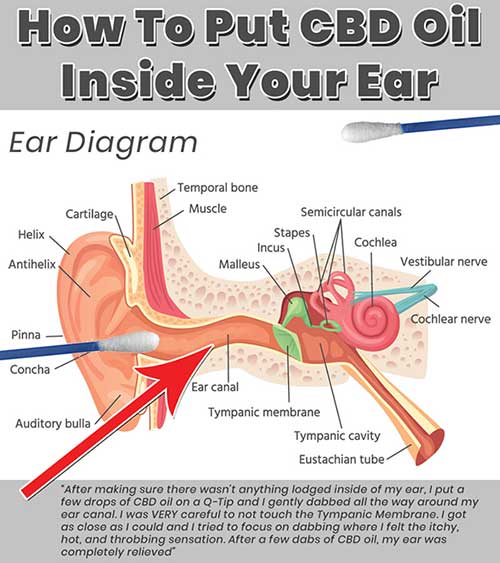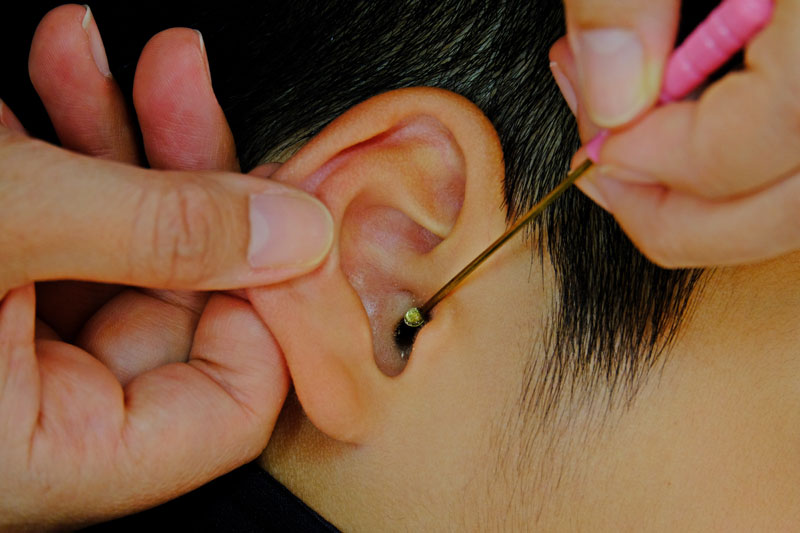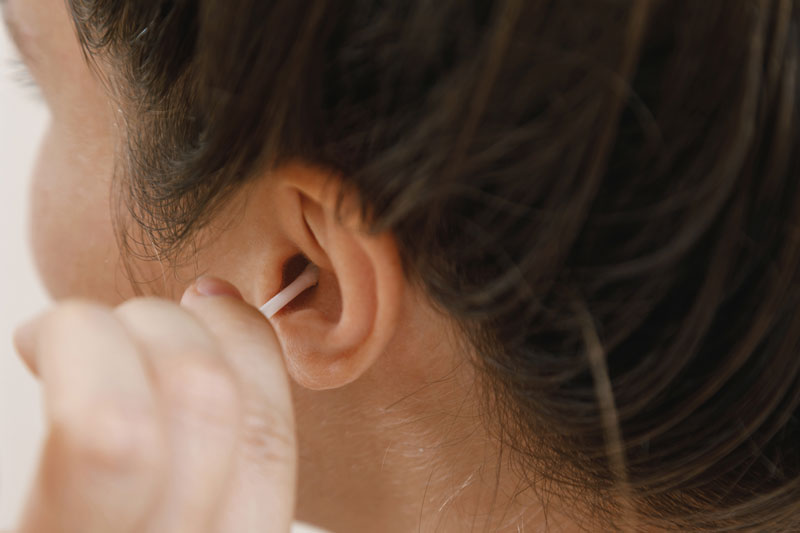When you need rapid ear support in the middle of the night — CBD oil drops are effective and if you don’t have CBD oil drops — there’s a simple DIY option most households already have available sitting on the pantry shelf.
For fast natural ear relief for mild ear issues, add warm drops of olive oil, coconut oil, or CBD oil inside the ear canal — with or w/o a Q-Tip. Before adding anything in your ear, make absolutely sure there’s nothing lodged in there or something worse. I use MedTerra’s Unflavored Broad-Spectrum CBD oil because there’s no THC, only two ingredients (cannabinoids & MCT oil), and gave me instant relief.
Below, I’ll tell you my quick story of how I decided to put CBD oil directly inside of my ear.
- What’s The Best CBD Oil Ear Drops?
- Are There Any Other Natural Things Available At Home You Can Use — If You Don’t Have Unflavored CBD Oil?
- Are people actually putting CBD oil directly inside of their ear?
- A Brief Caution Before Putting Anything Directly Inside Of Your Ear.
- Can you put CBD oil in your ear?
- What causes the ear to stop functioning like it should?
- Nutrition and nutrient deficiencies preventing normal ear function
- What are the prescription ear infection remedies?
- What are the different types of ear infections?
- What are the symptoms of ear infections?
- What are the causes of ear infections?
- Are ear infections contagious?
- Can you still get an ear infection if you have tubes?

What Are The Best CBD Oil Ear Drops?
After several years of trying different CBD oils and brands, my honest opinion is MedTerra’s Ultra Broad-Spectrum.
I give this specific CBD oil to friends & family and use it on my child when she’s in immediate need.
Not only can you put unflavored CBD oil inside of your ear canal, but you can also put it behind the ear, or nearly any dry skin areas for quick relief of mild irritations.
Why I recommend this specific CBD oil to put inside of your ear.
- I use MedTerra’s Ultra Broad-Spectrum, first of all — because the lab tests consistently show there are no detectable amounts of THC. ** Meaning it’s safe and legal in Idaho **
- Second, the unflavored one only has two organic ingredients — cannabinoids and MCT (coconut oil).
- No added flavor or other irritating ingredients.
- Pure clean effective CBD ear drops.
My mom likes buying CBD with flavoring.
However, I personally only buy the unflavored CBD tinctures because I can use them for several different applications.
Flavored CBD oils (with essential oils) probably should not be put on an open wound or in your ear.
Strawberry Mint or Citrus flavored CBD oils might irritate the inner ear or cause it to sting.
Flavored oils may taste great, but for practical emergency use, I only buy unflavored Broad-Spectrum.
Are There Any Other Natural Things Available At Home You Can Use — If You Don’t Have Unflavored CBD Oil?
The internet is chalked full of natural ear support remedies.
Some sources recommend simmering garlic into olive/coconut oil. Me personally, I’m not sure if I quite like the idea of making something that seemingly complicated at home and trying it my first time without the aid of an expert.
Other natural ear infection remedies for quick ear support include: (Source: Health Line)
- Alternating heating pad and ice pack – for ears (Heating pad & ice pack)
- Chiropractic adjustments. (More Information Source)
- Naturopathic ear drops from herb extracts. (More Information Source)
- Change sleep position
- Slow neck rotation exercises
If one solution doesn’t make your ear start operating normally, keep trying different methods until you find what works for you.
Are people actually putting CBD oil directly inside their ears?
I put CBD directly inside of my ear and it works great!
Before I put CBD oil inside of my ear, I asked several parents if they’d done it.
Several parents from various CBD groups on Facebook responded very positively and even put CBD oil inside of their little one’s ears.
Before attempting to experiment with putting CBD oil drop directly inside your ear, it may be wise to first speak with your primary health care practitioner.
The only warnings I found were there could be something lodged inside of your ear, your inner ear could be damaged, or something worse.
I’ve only used CBD oil inside of my ear for mild earaches and I’ve put CBD oil behind my little one’s ear with it gets dry.
A Brief Caution Before Putting Anything Directly Inside Of Your Ear.
Before putting anything inside your or your child’s ear, it’s best to have your doctor directly LOOK inside the ear.
Reasons to have a doctor look inside your ear, before adding drops, include:
- Make sure there’s not something “lodged” inside.
- Check for inner ear deterioration.
- Verify there’s not a tear in the eardrum.
And potentially other reasons.
My Personal Story Putting CBD Oil Directly Inside Of My Ear.
A few months ago, I woke up in the middle of the night to my inner ear itching, pulsating, and feeling kind of hot! Instinctively, I stuck my pinky finger in my ear and itched it a bit a few times.
It didn’t help and I wasn’t able to go back to sleep, due to the throbbing sensation on the entire left half of my head.
Then, I got the idea to maybe put CBD oil drops inside of my actual ear — because that’s all I had — it was worth a shot.
Since it was still the middle of the night, I knew I had to be careful, slow down, and think this through.
As I started thinking this through, I recalled my little one was sick with a cough, and as I was carrying her around through the day I remember her coughing directly into my left ear.
This got me thinking that there was probably not something lodged inside causing the pain and my eardrum probably wasn’t torn or punctured.
Very carefully, I took a Q-Tip and gently cleaned out a giant nasty piece of ear wax.
Upon taking out a massive chunk of earwax, the throbbing/itching feeling was still there, with no relief.
I started thinking that CBD was about the only thing I was going to consider putting in my ear.
The very next question was HOW am I going to put CBD in my ear?
I had a few bottles of “natural” CBD oil tinctures, that didn’t have any flavors, sugars, or other additives.
I felt like a basic simple CBD oil was the safest option to proceed in getting some CBD oil in my ear.
My next thought is, do I just turn my head sideways and try to let a few drops slide down and inside of my ear?
No. I didn’t really like the idea of having too much liquid rolling around on the inside of my ear.
Finally, I got the bright idea to add a few little drops of CBD oil onto a Q-Tip and gently dab on the inside of my ear where I thought the pain was coming from.
Low and behold, I only did this once (maybe twice) and my ear felt like it returned back to at least 80% normal feeling and function, basically instantly.
PHEW! WHAT A RELIEF!!
I then cleaned up my little mess, I laid back down, and I was able to quickly (and very happily) go back to sleep.
Upon waking up the next day, I did one more quick little application of CBD oil in my ear (using a Q-Tip) and my inner ear was pretty much all the way back to working and feeling normal.

Can you put CBD oil in your ear?
Short answer. Yes!
You can put CBD oil directly inside of your ear, but, you should probably exercise a wee-bit more caution than I did.
After doing a little bit of research, I came to understand why I probably should have taken a little bit more caution.
When I decided to put CBD oil drops in my ear, I should have exercised more caution.
But, I wanted relief NOW and I literally could not sleep due to the THROBBING itchy hot sensation pealing the left half of my face off.
So, I was as cautious as I could be and utilized the tools I had readily available and I took a little risk and it paid off.
Looking back, it would have been wise to have someone take a quick look inside my ear before putting CBD oil inside.

How to put CBD inside of your ear?
Below, I’ll walk you through the method that I used to put CBD oil drops inside my ear without any problems.
As mentioned above, proceed with extreme caution.
Steps to put CBD oil inside of your ear.
- Make sure there’s nothing lodged in your ear.
- Consult your doctor or purchase a cheap endoscope to look inside your ear yourself.
- Gently clean your ear out with a Q-Tip cotton swab.
- Place 2-3 drops of CBD oil on the Q-Tip cotton swab.
- Slowly start dabbing the inside of your ear canal.
- Repeat as necessary until normal function returns.
There might be other ways of getting CBD oil inside of your ear, however, this was the best way I could think of how to do it safely.
Below, I did some more deep research on normal ear function and how to restore healthy inner ear activity.
Throughout the article below, I scoured the internet to find any and all the information I could to prepare for the worst ear disfunction that could crop up.
I like being prepared. I don’t like to wait until the morning to visit the doctor. And I REALLY like having everything I need at home to quickly return my body functions back to normal operation.
Summary of what’s all jam-packed in the article below.
- Links on where to buy a diverse range of natural ear support aids
- Explanations of some of the natural products that can restore normal function
- Causes of your ear not functioning normally.
- A review of some medical journals and normal ear function
Without further delay, let’s dive into some of the more specific research on normal ear function and how to keep your inner ear operating properly.
What causes the ear to stop functioning as it should?
According to the United States Department Of Health & Human Services, the most common reason why children visit the physician is due to Otitis Media (middle ear inflammation) with or without fluid.
Healthline reveals ear infection is bacterial (or something else) and may not require prescription medication – to find relief.
According to Drugs.com, around 80% (or more) of ear infections will go away on their own.
Nutrition and nutrient deficiencies preventing normal ear function
A Medical Journal devoted to pediatrics, Annals Of Tropical Paediatrics, provides evidence for pathology (cause and effect) of the middle ear, acute, and Otitis Media.
Healthy Hearing lists other potential nutrients to help restore normal ear function.
Nutrient deficiencies preventing proper ear function:
- Zinc.
- Vitamin A.
- Magnesium.
- Vitamin B9 (Folic Acid).
In another article, I looked up every common fruit and vegetable and made a chart of all the 33 different nutrients in these whole foods. If you have a nutrient deficiency, you can download the PDF to the nutrients in the fruits and vegetable chart.
Nutrients In Fruits And Vegetables Chart – 33 Nutrient List Of 92 Fruits, Vegetables, Seeds, & Super Foods (Printable PDF Table/Chart)
Direct nutrient chart PDF download: Download & print a PDF spreadsheet (table)
What are the prescription ear infection remedies?
InformedHealth.org reports OTC (over-the-counter) ear drops lack any evidence suggesting they work better than a prescription-only ear infection drop.
Drugs.com, provides a list of 29 prescription drops for Otitis Externa (external ear canal inflammation, redness, and/or swelling) with patient reviews.
Side effects of “one” prescription ear drops include: (Source: WebMD.com)
- Mild irritation.
- Discomfort.
- Dizziness.
- Headache.
- Earache.
- Changes in taste.
- Potential allergic reaction.
- Rash.
- Itching.
- Swelling (face, tongue, throat).
- Trouble breathing.
- And potentially much more.
What are the different types of ear infections?
Types of ear infections are determined by a doctor giving an examination via a pus lab analysis or in some instances – a CT (Computerized Tomography) scan may be required.
Types of ear infections include: (Source).
- Acute mastoiditis. (Ear bone infection).
- Ear herpes zoster. (Infected auditory nerve via herpes zoster virus).
- Infections myringitis. (Eardrum inflammation – viral or bacterial).
- Otitis externa. (Ear canal inflammation or infection).
- Otitis media. (Cold triggered or Eustachian tube blockage).
- Serous otitis media. (Fluid or pus build-up via middle ear).
- Vestibular neuronitis. (Inflamed vestibular nerve – typically a viral infection)

What are the symptoms of ear infections?
Ear infection symptoms vary based on the type of ear infection your doctor’s diagnosis.
Common symptoms of ear infections include:
- Ear pain.
- Discharge from the ear.
- Fever.
- Outer ear itching.
- Muffled sound or mild deafness.
- Appetite loss.
- Outer ear or ear canal blistering.
- Hearing buzzing or humming noises in the ear.
- Loss of balance (vertigo).
- And potentially more.
Make a list of your symptoms before speaking with your healthcare physician about the best course.
What are the causes of ear infections?
Causes of ear infections can be either viral, bacterial or something else.
Research indicates that children are more likely to contract on inner/middle ear infection if they’re using a dummy pacifier, have close interactions with other children (nursery, daycare, school), formula-fed “not” breastfed directly from the mother, or exposed to tobacco smoke.
Development of ear infections are typically caused by: (Source).
- Cold.
- Flu.
- Sore throat.
- Similar infection.
- Virus.
- Bacteria.
- Respiratory infection.
- Air pressure changes (airline travel).
- Blocked Eustachian tube or smaller in size than what’s average.
- Cleft palate (opening/slit in the roof of the mouth).
- Swimming in dirty water.
- Not properly drying outer ears.
- Excessive ear cleaning – scratching sensitive tissues inside.
- And potentially more.
An inner ear infection typically occurs when a bacteria or virus makes its way inside the throat and causes the mucous membranes to get inflamed – causing more fluid.
Inflammation, swelling, also will occur in the ear membrane lining, Eustachian tube (middle ear canal connecting to the throat).
When these areas are swollen, extra fluid can “not” drain out.
With the building up of secreted fluid in the middle ear then begins to push on the eardrum.
Inflammation and fluid build-up pushing on the eardrum may begin to cause pain and make normal hearing diminish.
There are other ways the ear area can block the middle ear and trigger an increase of infection such as enlarged adenoids (tissue behind the nose, high up in the throat), allergic reaction, and sinus inflammation.
These conditions can cause a domino effect and potentially lead to swelling of the inner ear.
Are ear infections contagious?
An ear infection, by itself, are “not’ contagious.
However, according to Health Line, the bacteria or virus causing the infection might have a contagious component – such as the flu or cold or other types of conditions that are contagious.
Can you still get an ear infection if you have tubes?
Yes.
According to WebMD, you can still get an ear infection if you have tubes, however, it’s not as common.
An ear infection with tubes typically won’t cause you to lose your hearing and will typically go away on its own or with an ear drop.

